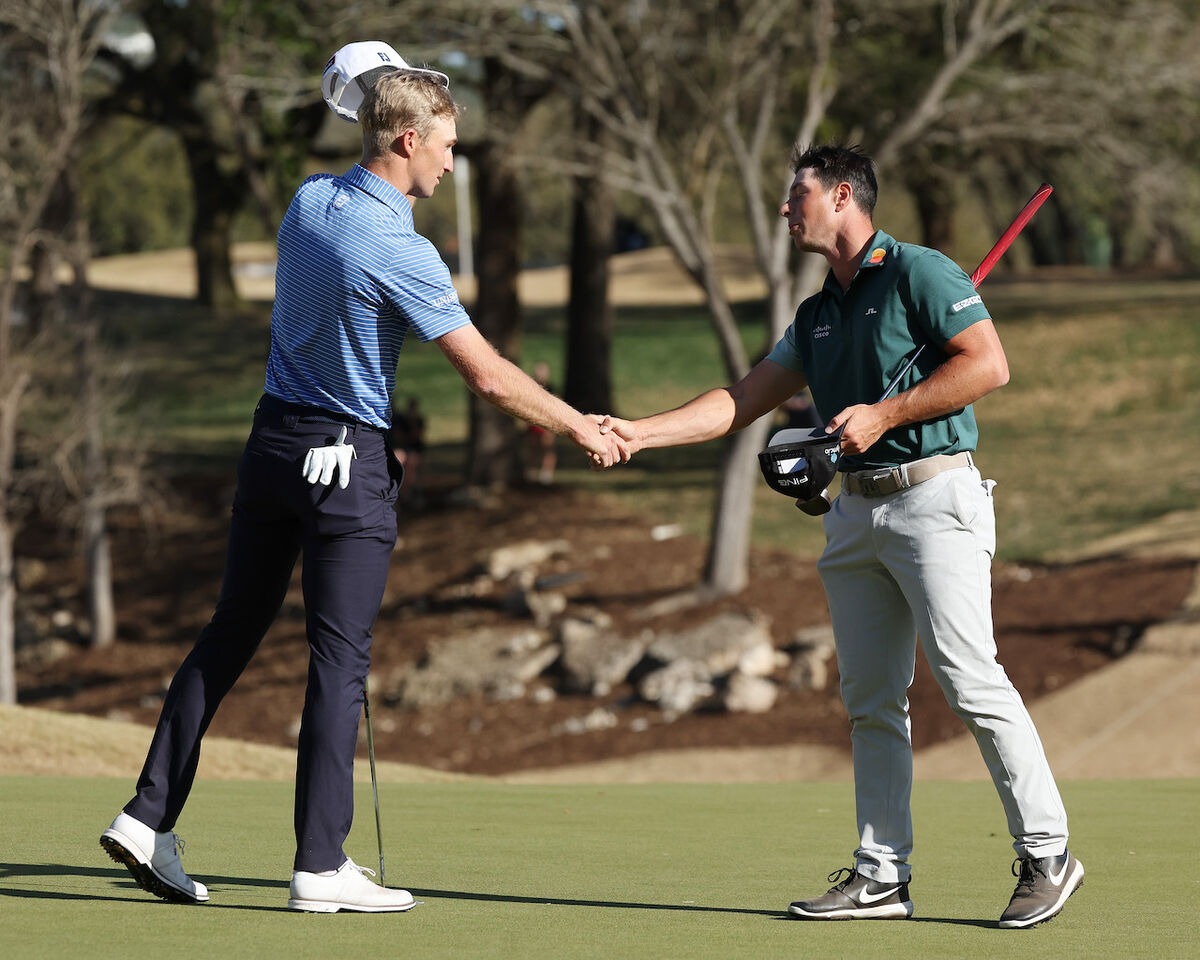Complete Guide to Match Play in Golf (Plus Winning Strategies!)

Match play is one of the most exciting formats in all of golf. Whether you just enjoy watching match play in professional golf or you organize match play for your own competitions, the format is a nice change of pace from standard stroke play. Let's take a look at some of the most popular match play events along with winning strategies should you find yourself going head-to-head with some stiff competition.
Match Play Format
Match play can be played as head-to-head competition between two, three, or four competitors. Instead of counting strokes throughout the round, a single point is awarded after each hole. That's why match rewards players who take chances, resulting in a more aggressive style of play.
Match play requires a different set of strategies than stroke play, because at the end of the round it's not about who shot the lower score, it's about who won the most holes.
How to Score Match Play
Scoring match play is actually quite simple, it's also easy to mark on your scorecard. Instead of keeping a running total of strokes, players always know they're standing in the match with a few simple markings. Here are the basics behind scoring match play.
- Each hole is worth a point. The idea is to win as many holes/points as you can until your opponent(s) doesn't have enough holes remaining to even or beat your total.
- Each player plays the first hole, coutning strokes as they normally would. At the end of the of the first hole, the player with the lowest score is 1 up on the other.
- In the event players tie on a hole, no point is awared to either side and the hole is a wash. When match play is between more than two players, the chances of ties greatly increases.
- As you progress through the round, one player can be up multiple holes or it can go back and forth between small leads and all square.
- The final score in match play is given as the number of holes the winner led by, and the number of holes that remained when the match was decided. When one player or side leads by more holes than remain, they have won the match. The earliest an 18-hole match could end is through 10 holes. If one player wins the first nine holes then ties the tenth hole, they would have a nine hole lead with eight to play, and the final score would be 9&8.
Depending on how closely matched the competitors are, most match play events end in the closing stretch of holes with final scores such as 2&1 (ended on the 17th hole), 3&2 (ended on the 16th hole), and so on.
Matches commonly end in a tie. Depending on the type of event, the match may go to a sudden death playoff (the next player to win a hole wins the match) or end in a tie. For example, Ryder Cup matches that end in a tie are halved, and each side earns half a point. On the other hand, matches in the U.S. Amateur must determine a winner, and the two players continue the match until somebody wins.
Golf Rules and Match Play
In general, the USGA Rules of Golf apply in match play as they do in stroke play. All of the common rules regarding out of bounds, green rulings, unplayable shots, are all consistent.
However, there are some subtle rules differences between stroke play and match play. For example, any rules infraction that results in the general penalty is different in stroke play than match play. In match play, the general penalty results in loss of the hole, while in stroke play it is simply two strokes. Here are a coulple scenarios where match play rules and procedures differ from stroke play.
Concessions

Concessions are a big part of any match play contest and they can also set the tone for the entire match. Golfers typically make concessions on short putts when the opponent has little chance of missing.
It's important to be consistent with your concessions, if that's your intent. Some players take offense when short putts aren't conceded. However, some players like to strategize their concessions (more on how to do that later). The most important rule with conceding a putt is that you cannot take it back after you make the concession.
Order of Play
In match play, the order of play should always be honored. The player who won the previous hole is first to tee off. If the previous hole was halved the honor on the tee remains with the player who held it on the previous hole.
Throughout the rest of the hole, the player who is farthest from the hole always plays next. There is no stroke penalty for playing out of turn in match play, but your opponent may cancel your shot and require you to replay it if you play out of turn.
Match Play Strategies
Match play has different strategies than stroke play. Here are a few things to consider if you find yourself in an important match.
Honors
As previously mentioned, tee box honors go to the player who won the previous hole. When you're teeing off second, note where your opponent places their tee shot. If you're debating between a risky or safe strategy on a hole, your opponent's position off the tee can help make that decision easier. If they hit a shot into Position-A, you might need to go for the high-risk, high-reward play. However, if they get into trouble off the tee, a safe and easy play may be all you need to win the hole.
Playing Aggressive
Aggressive play such as risky lines on tee shots and going for par 5s in two shots is often requires risk to potentially earn the reward, and that style of play can payoff big time when you execute the risky shots. There are two ways to view aggressive play in match play:
- You're winning the match. You're looking to grow your lead, and taking a few risks could potentially take you from being two holes up to three or four. From an intimidation standpoint, pulling off a few high-risk shots can deflate your opponent.
- You're losing the match. You need to start climbing back into contention or you'll be done in just a few short holes. Aggressive play can send a message to your opponent that you're not backing down and could cause them to play out of sync.
When to Make Them Putt
We mentioned earlier that some players like to strategize when they concede putts, and when they make their opponents finish them out. Here's how they do it.
For example sake, let's say you give your opponent every putt inside three feet through the first 15 holes. The match is all square on the 16th green and your opponent has a three-foot putt to tie the hole, and instead of telling them to pick it up, you remain silent for the first time all day.
In this scenario, you are hoping to gain two advantages. First, your opponent is likely to be a little irritated that you are making them clean up their three-footer. This can cause even a slight distraction that could hinder their focus and execution. Second, as the opponent stands over the three-footer, they'll realize they haven't made a putt of this length all day and perhaps a little doubt will creep in, making the three-footer look a lot longer.
Putt With Purpose
There's a time on the golf course to play safety putts, and match play is not one of those times. Unless your opponent is an atrocious putter and you know you can get away with two-putts on every green, you should always look to drain every putt, whether if it's from 10 feet or 50 feet. If this strategy rewards you with a 40-footer in the bottom of the cup for birdie, you will have instantly struck fear into your opponent.
Play Your Game
Unless you find yourself down multiple holes and need to get aggressive, you shouldn't alter your game too much for match play. Know what you do well, what holes you play well, and where you need to play a little safe. If you trust your game and have confidence that you can beat your opponent, the only thing in the way is you.
Match Play in Professional Golf
Match play is played in several professional and high-level amateur golf events, including:
- Ryder Cup
- Presidents Cup
- Solheim Cup
- Curtis Cup
- Arnold Palmer Cup
- U.S. Amateur
- NCAA Championships
Conclusion
If you have the opportunity to play in a match play format, either in a tournament or among friends, you'll learn a lot about your game and competitive golf. It can be a fun venture to shake up your normal stroke play rounds. Just be sure to use our tips and strategies to get a leg up on your competition.